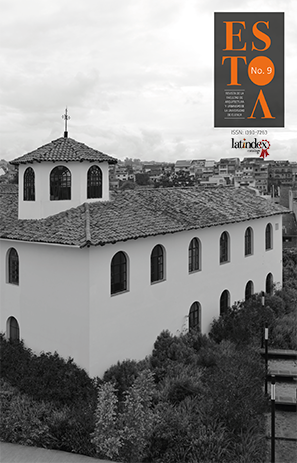Agreed Statements of the Workshop-Seminar: “Sustainable Architecture” A Bioclimatic Strategies Approach: The Ecuadorian Case
DOI:
https://doi.org/10.18537/est.v005.n009.11Abstract
This paper exhibits the results achieved in the 1st Workshop-Seminar “Sustainable Architecture: The Ecuadorian Case”, which was accomplished as partial branch of the main research project “Sustainability Criteria Assessment of Buildings in Emerging Countries: The Ecuadorian Case”. Through this event, researchers expect to develop an assessment tool to evaluate sustainable building characteristics focused in a bioclimatic approach. Identify climate zones allow a realistic interpretation of the bioclimatic concepts analyzed. Five case studies were expounded to the experts’ judgment in order to ascertain design strategies needed in early stages of building planning. The start points of this research process are the concepts that arise from the professional and academic experiences of the participants. As a result of this seminar a validation proposal is reached, which allows the corroboration of the research findings.
Keywords: Sustainable Architecture, Architectural Design, Bioclimatic Architecture, Climatic Zones.
Downloads
References
Celis D'Amico, F. Arquitectura bioclimática, conceptos básicos y panorama actual (2000). Recuperado el 11/02/2016 de Biblioteca CF+S Ciudades para un futuro más sostenible: http://habitat.aq.upm.es/boletin/n14/afcel.html
Cordero, R., Luna, V., Sánchez, J., de Guzmán, A., Jiménez, A., & García. Particularidades climáticas del Ecuador y su influencia en el confort de las edificaciones. El caso de la localidad de Guayaquil (189-198). Guimarães, Portugal. 2015. Recuperado el 02/11/2015 de http://civil.uminho.pt/Euro-ELECS-2015/files/Euro-ELECS_2015-Proceedings_Vol1.pdf
De Garrido, L. Proceso de diseño bioclimático. Control ambiental arquitectónico 2015. Recuperado el 24/01/2016 de http://luisdegarrido.com/publications/design-methodology-luis-de-garrido/
Dong, X., Soebarto, V., & Griffith, M. “Strategies for reducing heating and cooling loads of uninsulated rammed earth wall houses”. Energy and Buildings 77 (2014): 323-331. Recuperado el 28/12/2015 de http://doi.org/10.1016/j.enbuild.2014.03.031
Escobar, J., & Cuervo, Á. “Validez de contenido y juicio de expertos: una aproximación a su utilización”. En Avances en medición 6 (2008): 27-36.
Estenssoro, F. El ecodesarrollo como concepto precursor del desarrollo sustentable y su influencia en América Latina. Talca: Universum 30. 1 (2015): 81-99.
ICE. “Técnicas de Comunicación Oral”. Colección: Desarrollo personal y laboral. 2015. Recuperado el 30/12/2015 de https://www.grupoice.com/wps/wcm/connect/e256d874-1c8e-41fd-a808-5087f331afe7/2.pdf?MOD=AJPERES
INAMHI. Climas del Ecuador. Ecuador, 2006. Recuperado el 05/02/2016 de http://www.serviciometeorologico.gob.ec/wp-content/MapasBiblioteca/1%20Climas%20del%20EcuadorA0.pdf
Javier, N. G. “El Clima y los Invariantes Bioclimáticos de la Arquitectura Popular (II). Los Climas de Latitudes Bajas: Los Climas Cálidos y Húmedos”. Cuadernos del Instituto Juan de Herrera de la Escuela de Arquitectura de Madrid. España, 2013.
Jong-Jin, K., & Rigdon. “Introduction to Sustainable Design”. National Pollution Prevention Center for Higher Education 28, 1998.
Lowe, C., & Ponce, A. An international review of sustainable building performance indicators & benchmarks. UNEP-FI/SBCI’S financial & sustainability metrics report 2010. Recuperado el 20/03/2014 de http://www.unepfi.org/fileadmin/documents/metrics_report_01.pdf
http://www.nachhaltiges-immobilieninvestment.de/documents/UNEPFI_SUSTAINABILITY_METRICS_REPORT_2009.pdf
Meadows, D. H., & de Graue, M. S. L. Los límites del crecimiento: informe al Club de Roma sobre el predicamento de la humanidad. México: Fondo de cultura económica México, 1972. Recuperado el 15/01/2016 de http://ecaths1.s3.amazonaws.com/geografiapoblacion/454577910.tmzapiain-limitesalcrecimiento.pdf
Miño-Rodríguez, I., Gaona, G., Lobato, A., & Labus, J. “Implementation of simple GIS methodology and bioclimatic strategies to improve the quality of social housing in the Andean region of Ecuador”. World Sustainable Buildings. Barcelona, (2014):148-156. Recuperado el 12/11/2015 de https://www.researchgate.net/publication/279916526_Implementation_of_simple_GIS_methodology_and_bioclimatic_strategies_to_improve_the_quality_of_social_housing_in_the_Andean_region_of_Ecuador
Naredo, J. M. “Sobre el origen, el uso y el contenido del término sostenible”. Documentación Social 102 (1996): 129-147.
Neila González, J. “Los Climas de Latitudes Altas y Clima de Montaña: Los Climas Fríos”. El Clima y los Invariantes Bioclimáticos de la Arquitectura Popular IV. Recuperado el 20/02/2015 de http://www.aq.upm.es/of/jherrera
Neila González, J. Estrategias Bioclimáticas para condiciones de Verano I. Instituto Juan de Herrera: s. f.
Neila González, J. Neila González, J. Estrategias Bioclimáticas para condiciones de Verano II. Instituto Juan de Herrera, s. f.
Neila González, J. “Arquitectura bioclimática en un entorno sostenible: buenas prácticas edificatorias”. Boletín CF+S (2014):14.
Pérez, S. M. El debate sobre el desarrollo sustentable o sostenible y las experiencias internacionales de desarrollo urbano sustentable. 2007. Recuperado el 05/02/2016 de http://moodlelandivar.url.edu.gt/url/oa/fcps/GPT/contenido/Modulo1/Tema9/Debate_sobre_el_desarrollo_sustentable_o_sostenible.pdf
Robles, P., & Rojas, M. La validación por juicio de expertos: dos investigaciones cualitativas en Lingüística aplicada, 18 (2015).
Ron, S., Guayasamín, J., Yanez-Muñoz, M., Merino-Viteri, A., Ortiz, D., & Nicolalde, D. Regiones Naturales. Recuperado el 01/03/2016 de http://zoologia.puce.edu.ec/Vertebrados/anfibios/AnfibiosEcuador/regionesNaturales.aspx
Sánchez, J. “La Cubierta: La búsqueda de confort climático en la zona tropical húmeda del Ecuador”. En Congreso Nacional de Medio Ambiente 2014 7. Recuperado el 11/11/2015 de
http://www.conama.org/conama/download/files/conama2014/CT%202014/1896711411.pdf
UPM. “Particularidades Climáticas del Ecuador y su influencia en las Edificaciones y en las condiciones de confort de los edificios”. Análisis Climático del Ecuador N° PT01 - ACT. 1.1, 88. Madrid: Universidad Politécnica de Madrid, 2014.
World Commission on Environment and Development. Our Common Future Oxford. Oxford University Press, 1987. Recuperado el 06/02/2016 de http://www.worldcat.org/title/our-common-future/oclc/15489268
Downloads
Published
How to Cite
Issue
Section
License
The Journal declines any responsibility for possible conflicts derived from the authorship of the works that are published in it.
The University of Cuenca in Ecuador conserves the patrimonial rights (copyright) of the published works and will favor the reuse of the same ones, these can be: copy, use, diffuse, transmit and expose publicly.
Unless otherwise indicated, all contents of the electronic edition are distributed under a Creative Commons Attribution-NonCommercial-ShareAlike 4.0 International License.




